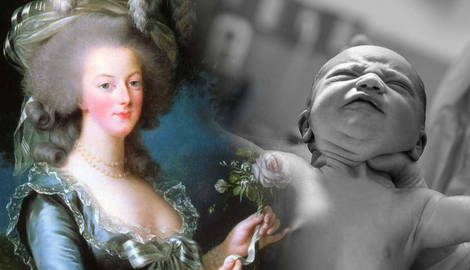
In one of the most unusual traditions in history, royal queens customarily gave birth in front of huge crowds. The bizarre and cruel trend arose in order for witnesses to ensure the baby was safely delivered, and that there was no trickery or scandal taking place. French Queen consort Marie Antoinette gave birth to her first child in front of a swarm of 200 people at the palace of Versailles, including princesses, dukes, countesses, and royal staff. However, the experience was so horrifying for her that her subsequent three births were a far more private affair.
Marie Antoinette Was Expected to Give Birth in Public

French King Louis XIV, known as ‘The Sun’, issued a decree to ensure all queens and princesses should give birth in public. He instilled the rule in order to ensure that a legitimate royal child was being born, and to make sure no imposter child could be placed in the royal household. Witnesses were also present in order to confirm the sex of the baby, at a time when only sons were allowed to continue the leadership of the throne. Marie Antoinette was expected to follow the same tradition as her ancestors, whether or not she actually wanted to.
Her First Birth Was Attended by Huge Crowds

One of the reasons why Marie Antoinette’s first birth was such a popular event was because her child had been a long time coming. In fact, it was eight years into her marriage to King Louis XVI before the queen conceived a child, making the final arrival of the new royal a hotly anticipated occurrence. When news broke of her first birth in 1778, a huge swarm of up to 200 onlookers from the palace of Versailles gathered to watch as the long-awaited royal baby was born.
One chambermaid gave a shocking account of the build up to the great event, noting, “When the obstetrician said aloud, ‘The Queen is going to give birth!’, the persons who poured into the chamber were so numerous that the rush nearly killed the Queen.” She even described how two chimney sweeps “climbed up onto the furniture for a better sight.”
The Birth Did Not Go Well

The crush of people was only the beginning of Marie Antoinette’s problems during her traumatic birth. In fact, she was in labor for twelve hours before the baby was born. Following the birth, she collapsed and had a convulsive fit. The chambermaid described how the oppressive atmosphere had led to the queen’s subsequent collapse, noting, “the arrival of the inquisitives… sucked the air out of the Queen’s bed chamber, which then caused the room to become hot and stifling. Blood rushed to the queen’s head, and she fainted. For a moment everyone thought she had died.”
Her collapse meant she did not find out the gender of her baby for a full hour after giving birth. While the public had hoped for a boy, the Queen was reportedly delighted with her baby girl, Marie-Therese, as a record of her first words to her new baby prove: “You shall be mine; you shall have my undivided care, shall share all my happiness, and console me in my troubles.”
Subsequent Births Were More Private

Given the traumatic nature of her first birth, the King changed the rules surrounding Marie Antoinette’s subsequent three birthing experiences. While she still had an audience of onlookers made up of trusted ministers and advisors during each of her following births to Louis Xavier Francois, Louis XVII, and Sophie Helene Beatrix the spectators were far fewer, resulting in a much easier and more straightforward experience for the Queen.










